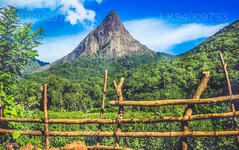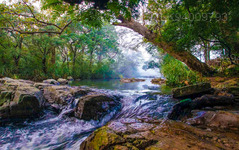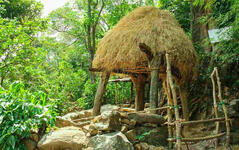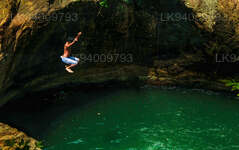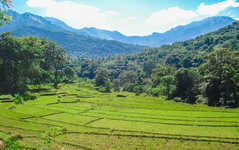
Kandy-stad
Kandy, een pittoreske stad in centraal Sri Lanka, staat bekend om zijn rijke culturele erfgoed, levendige festivals en schilderachtige schoonheid. Gelegen tussen weelderige heuvels, herbergt de stad de Tempel van de Tand, een UNESCO-werelderfgoed, en biedt een fascinerende mix van geschiedenis en natuurlijke pracht.
Meemure
Meemure is an isolated village in the Central Province of Sri Lanka, located 324m above sea level and hidden amongst the mountains. The only way to reach it is from the ‘Hunnasgiriya’ mountain, which is part of the Knuckles range, approximately 50km from Kandy. It’s a difficult trail of 33km from Hunnasgiriya to Meemure with many tricky spots, though the view along it is excellent. The village itself receives abundant water in the form of waterfalls that have their sources in the evergreen forests of the Knuckles. East of the village lies the pyramid shaped Lakegala mountain; while the west is dominated by the picturesque Knuckles range. The northern boundary of Meemure borders a forest which runs to the ‘Pitawala Pathana’ grassland; and the south is bounded by Heen River.
Pack-bulls used to be the solitary method of transport to Meemure until 2004. Herds of cattle carried sacks full of goods and equipment to the village. Due to the fertility and prosperity of the village; the pack-bulls were only used to carry salt, cloths, tobacco and calcium bicarbonate. But with the invasion of modern technology, the trails have been widened to allow three wheelers, jeeps and small trucks.
Folklore and History
Meemure received its name from the ‘Mee’ trees (as the villagers called them) that surrounded the place.
According to the folklore the village dates back to almost 5000 years ago. Lakegala that that lies to the east is believed to have been the property of the legendary King Ravana from the Indian literary epic Ramayana. As the stories go, Lakegala was used by Ravana as a power source and there was a tunnel through Lakegala in the times of Ramayana. It is said the tunnel was sealed after the war of Ramayana with the corpse of Ravana placed within it.
Another story states dates to 700 B.C which was the era of King Vijaya who is believed to be the forefather of the current population of Sri Lanka. Vijaya arrived on the island from India with his followers and caught sight of the shapely primitive woman Kuweni. He was overtaken by lust and took Kuweni as his informal wife. Kuweni bore him two children, but then Vijaya banished her from his castle when he formally married a royal princess from India. Hence Kuweni was forced to take her move into the forest along with her children. It is believed that they lived in the forest where Meemure is located, and that the indigenous people of Sri Lanka originated from the two children of Kuweni. The indigenous people of modern Sri Lanka are based just 60km from Meemure in Mahiyanganaya; and seem to prove this belief to be the truth.
During the 16th century AD Sri Lanka was invaded by Portugal. The invasions continued through the centuries as the Dutch and English nations conquered the country subsequently. The annals of history state that the people of Meemure supplied saltpetre (potassium nitrate) for the gunpowder used by the Kandyan kingdom in their efforts of resistance. The cave that the saltpetre was (niter) was mined from still exists to this day.
During the same era, King Sri Wickrama Rajasinghe is said to have banished his daughter with a group men, one of whom he believed his daughter was having an affair with, to the village of Meemure. This solidifies the claim that Meemure in existence at the time.
Bio Diversity
- Meemure spans an area of 700 acres with Heen River passing through it.
- Ravana Ella Falls also lie within these lands, fed by a stream from the eastern slope of the Knuckles.
- The network of streams that run through Meemure, originate from the Knuckles; and are home to over 25 species of freshwater fish, of which 8 are endemic and 7 nationally threatened.
- The vegetation is typical to the Knuckles region and ranges from lowland semi-evergreen forests to Montana forests.
- There have been over 130 species of birds recorded in the area, with approximately 10 migrant species and 20 endangered ones.
- Out of the 20 species of Amphibians that have been seen in the wilderness, 12 are endemic and are considered nationally endangered.
Life in the Village
The village has a population of approximately 400 with about 125 families. The architecture is one of the main identities of Meemure. The villagers build eco-friendly homes using clay and illuk (spear grass) which lasts for over three decades. But the most unique aspect of their buildings are their boundary walls made of quartz.
Before cardamom cultivation was banned in 1982 due to the Forest Preservation Act, Meemure villagers earned their bread by harvesting the spice. After this they shifted to chena cultivation, paddy cultivation and pepper cultivation.
Nowadays some of the peasants earn their living by taking care of jaggery palms, which produce toddy and treacle. The village has one tiny village shop where the locals buy necessities such as salt and sugar; and no cable telephone or mobile network signal. The village does have CDMA telephone services, though, to some extent.
The villagers don’t have direct mail delivery to the village, either; and have to journey to Thapal Junction each day to exchange incoming and outgoing post with the postman.
Nearby Attractions
- Lakegala: Lakegala is a mysterious looking pyramid mountain that is 1314m tall. The mountain bears many unmarked ruins, including caves with evidence of ancient human inhabitation. Some of the other attraction in the Lakegala region are Nawathna Waterfall, Ravana Falls and hiking trails in the deeps of Lakegala.
- The village of Gala Muduna: This remote village lies south of Meemure and has just 20 families. Mostly untainted by the outside world; Gala Maduna has only a single junior school. As such, the villagers only learn up till they are 14 years old. The place is so remote that when people get sick they are taken to the hospital in a sling made of a sack tied to two sticks; and there is no telephone service at all. The trail to the village is rich with flora and fauna of the Knuckles ecosystem. The village itself gains its name,Gala Muduna, due to its being situated on a top of a large rock.
- Heen Ganga: There are three major rivers that originate from the Knuckles and pass through the region; Heen Ganga, Hulu Ganga and Kalu Ganga. Heen ganga, in specific, begins from eastern slopes of the Knuckles range; flows approximately 36km through Corbett gap and Kalupahana; an finally joins the Mahaweli, the longest river of Sri Lanka. Ancient forests and diverse rocky plates line its banks. However, the Match Box Bridge. Here lies a veritable paradise of tinkling water falls, caves, and vibrant nature. This part of the river is also home to Bulath Happaya, an endemic species of fish. The only home within this stretch of land belongs to an elderly man called Heen Banda. He is often happy to have vistors, and will share his experiences and life story.
Over het district Kandy
Het district Kandy ligt in de centrale provincie van Sri Lanka. Kandy, een van de zeven werelderfgoedlocaties in Sri Lanka, was ooit de thuisbasis van de Kandyaanse koningen van weleer in de 16e eeuw en een bron voor alle muziek, kunst, ambachten en cultuur in het land. Kandy ligt op ongeveer 129 km van Colombo en is genesteld in een heuvelachtig terrein en alle ogen worden getrokken naar het centrum van de stad, waar het Kandy-meer een charmant kenmerk vormt. Kandy behoudt een grote religieuze betekenis voor Sri Lanka, omdat in deze charmante stad de Dalada Maligawa of "Tempel van de Tand" zich bevindt, waarin de heilige tand van Boeddha goed bewaard wordt. De Koninklijke Botanische Tuin, Peradeniya, ligt ongeveer 5 km ten westen van het stadscentrum in Peradeniya en wordt jaarlijks door 1,2 miljoen mensen bezocht. Het is de grootste botanische tuin op het eiland. De Udawatta Kele (Udawatta-bos) is een beschermd heiligdom in het hart van de stad, net ten noorden van de Tempel van de Tand. Kandy is een stad met een Sinhalese meerderheid; er zijn aanzienlijke gemeenschappen die behoren tot andere etnische groepen, zoals Moren en Tamils. Kandy is, na Colombo, het centrum van de Sri Lankaanse economie. Veel grote bedrijven hebben grote vestigingen in Kandy en veel industrieën, waaronder textiel, meubels, informatietechnologie en sieraden, zijn hier te vinden. Veel landbouwonderzoekscentra bevinden zich in de stad. Het is tevens een bron van alle muziek, kunst, ambachten en cultuur van het land. Op ongeveer 129 km van Colombo ligt Kandy verscholen in een heuvelachtig gebied en alle ogen worden getrokken naar het centrum van de stad, waar het Kandymeer een charmant kenmerk vormt. Kandy heeft een grote religieuze betekenis voor Sri Lanka, omdat in deze charmante stad de Dalada Maligawa, oftewel Tempel van de Tand, is gevestigd, waar de heilige tand van Boeddha goed bewaard wordt.
Over de Centrale Provincie
De Centrale Provincie van Sri Lanka bestaat voornamelijk uit bergachtig terrein. De provincie heeft een oppervlakte van 5.674 km² en een bevolking van 2.421.148. Enkele belangrijke steden zijn Kandy, Gampola (24.730), Nuwara Eliya en Bandarawela. De bevolking is een mix van Singalezen, Tamils en Moren. Zowel de heuvelhoofdstad Kandy als de stad Nuwara Eliya, evenals Sri Pada, liggen in de Centrale Provincie. De provincie produceert een groot deel van de beroemde Ceylonthee, die in de jaren 1860 door de Britten werd geplant nadat een verwoestende ziekte alle koffieplantages in de provincie had vernietigd. De Centrale Provincie trekt veel toeristen, met heuvelstadjes zoals Kandy, Gampola, Hatton en Nuwara Eliya. De Tempeltand, of Dalada Maligawa, is de belangrijkste heilige plaats in de provincie Centrel. Het klimaat is koel en veel gebieden boven de 1500 meter hoogte hebben vaak koude nachten. De westelijke hellingen zijn erg nat, met op sommige plaatsen bijna 7000 mm regen per jaar. De oostelijke hellingen behoren tot de middeldroge zone, omdat ze alleen regen ontvangen van de noordoostelijke moesson. De temperaturen variëren van 24 °C in Kandy tot slechts 16 °C in Nuwara Eliya, dat 1889 m boven zeeniveau ligt. De hoogste bergen van Sri Lanka liggen in de Centrale Provincie. Het terrein is overwegend bergachtig, met diepe valleien die het doorsnijden. De twee belangrijkste berggebieden zijn het Centraal Massief en het Knuckles-gebergte ten oosten van Kandy.

